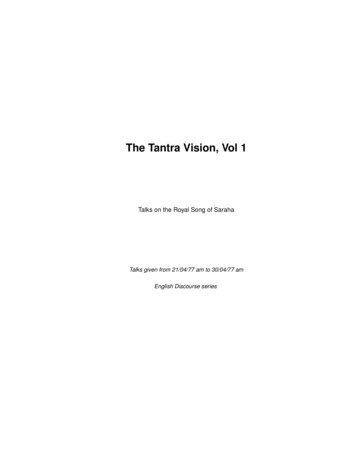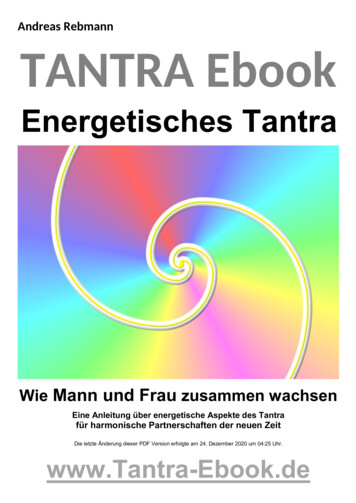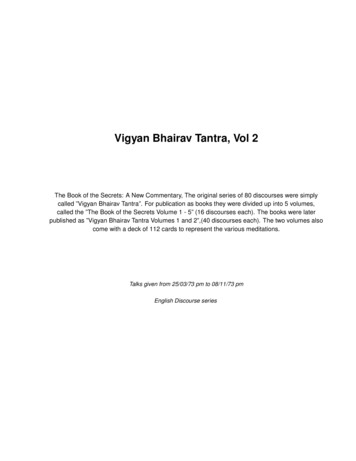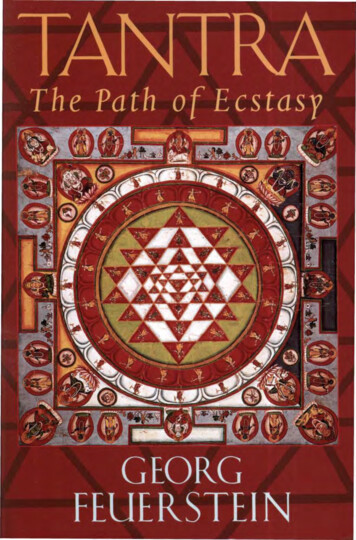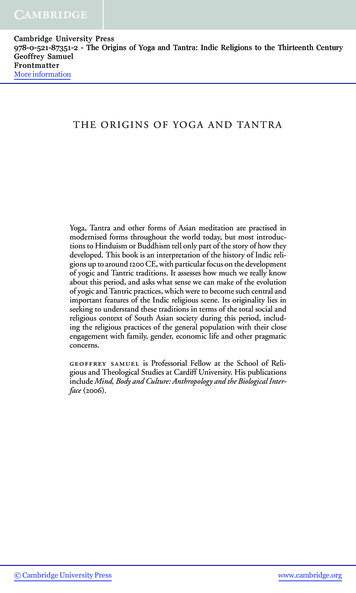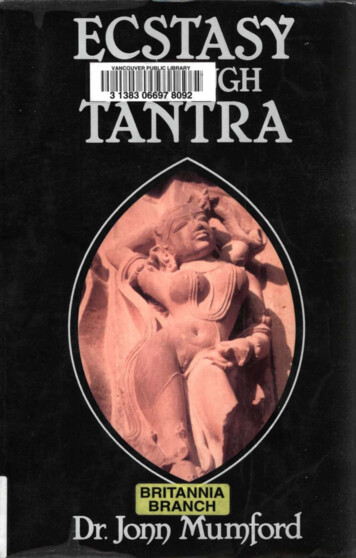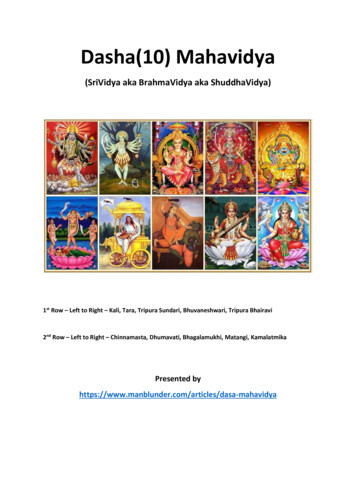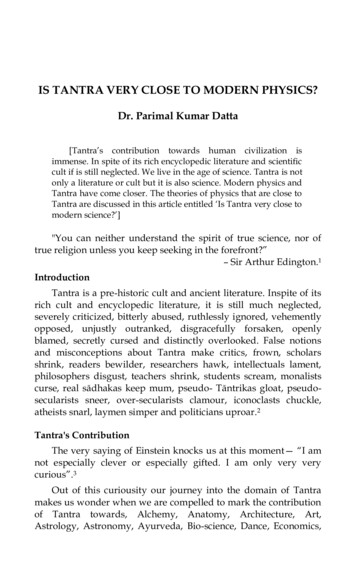
Transcription
IS TANTRA VERY CLOSE TO MODERN PHYSICS?Dr. Parimal Kumar Datta[Tantra’s contribution towards human civilization isimmense. In spite of its rich encyclopedic literature and scientificcult if is still neglected. We live in the age of science. Tantra is notonly a literature or cult but it is also science. Modern physics andTantra have come closer. The theories of physics that are close toTantra are discussed in this article entitled ‘Is Tantra very close tomodern science?’]"You can neither understand the spirit of true science, nor oftrue religion unless you keep seeking in the forefront?”– Sir Arthur Edington.1IntroductionTantra is a pre-historic cult and ancient literature. Inspite of itsrich cult and encyclopedic literature, it is still much neglected,severely criticized, bitterly abused, ruthlessly ignored, vehementlyopposed, unjustly outranked, disgracefully forsaken, openlyblamed, secretly cursed and distinctly overlooked. False notionsand misconceptions about Tantra make critics, frown, scholarsshrink, readers bewilder, researchers hawk, intellectuals lament,philosophers disgust, teachers shrink, students scream, monalistscurse, real sādhakas keep mum, pseudo- Tāntrikas gloat, pseudosecularists sneer, over-secularists clamour, iconoclasts chuckle,atheists snarl, laymen simper and politicians uproar.2Tantra's ContributionThe very saying of Einstein knocks us at this moment— “I amnot especially clever or especially gifted. I am only very verycurious”.3Out of this curiousity our journey into the domain of Tantramakes us wonder when we are compelled to mark the contributionof Tantra towards, Alchemy, Anatomy, Architecture, Art,Astrology, Astronomy, Ayurveda, Bio-science, Dance, Economics,
Geography, Geometry, History, Iconography, Law, Literature,Mathematics, Magic, Music, Philosophy, Physics, Physiology,Psychology, Religion, Symbolic Science and Yoga.4Tantra and ScienceDr. Capra in his book "The Tao of Physics" rightly comments, 5"Eastern thought, and more generally mystical thought,provide a consistent and relevant philosophical background to thetheories of contemporary science.”Tantra is science. Tantra is a way of religion. In this context wemay remember Einstein6,"Science without religion is lame.Religion without science is blind"Tantra and PhysicsTantra is a sādhanāśāstra with science7. Modern physicists nowagree to some postulations of Tantra8. Finn finds peculiarsimilarities between physics and Tantra9.In this article "Is Tantra very close to modem science?", ourattempt is to show how Tantra and modern physics expressstriking similar views and some concepts of modem science.Great scholars observe,l0"Tantra's notions concerning time and space, the nature of lightand heat, gravity and magnetic attraction, the wave theory ofsound are strikingly similar to the concepts of modem science. Itmust, however, be borne in mind that these scientificgeneralizations were based on intuitive insight, Yogic visions andpractices and intense observation of natural phenomenonconditioned by an ontological viewpoint, and were not determinedby experiments carried out in accordance with modem methods.These discoveries have a direct bearing on Tantric thought, itsprecepts and practices. As for example, astronomical observationsfor Tāntrics, have a utilitarian value in so far as they are used todetermine auspicious times for rites and rituals and also areindicators to man's destiny in relation to the varying positions ofthe planets.
3Big Bang Theory of PhysicsThe Big Bang Theory is the idea that the universe began with asingle large explosion and that the pieces are still flying apart. 11Its essential feature is the emergence of the universe from astate of extremely high temperature and destiny. The so-called bigbang occurred at least 10,000,000,000 years ago. The universe hasno edge, so that the big bang again occurred not at a particularpoint in space but rather throughout space at the same time.12According to a modem cosmologist of Belgium, "This universeis created due to the bursting of a great and original Bindu.”13Quantum Mechanics of PhysicsThe word 'quantum' means the minimum amount of anyphysical entity involved in an interaction. Quantum Mechanics orQuantum Physics or Quantum Theory is a branch of Physics. Itprovides a mathematical description of much of the dual particleand wave-like behaviour and interactions of energy and matter.14When light is absorbed by some material, the energy of thematerial does not rise continuously, but in discrete jumps. Eachjump occurs when the material absorbs a single quantum of light.Energy levels (orbits) of electron in an atom do not have acontinuous range of possible energies, but instead that onlydiscrete 'orbits' are possible. This strange behaviour is linked to theconcept of wave-particle duality. It is an outgrowth of the conceptthat all forms of energy are released in discrete units or bundlecalled quanta.15Moreover, according to Quantum Mechanics, electrons cansometimes move in erratic directions in an apparent whimsicalmanner which may be construed as a manifestation ofconsciousness.16Theory of Relativity of PhysicsThe Theory of Relativity of Physics usually encompasses twotheories by Albert Einstein, special relativity and generalrelativity.17The Special Theory of Relativity of Physics essentially dealswith the question of whether rest or motion and or relative or
4absolute and with the consequence of Einstein's conjecture thatthey are relative.18The General Theory of Relativity primarily applies to particlesas they accelerate, particularly due to gravitation and acts as aradical revision of Newton's theory, predicting important newresults for fast moving or very massive bodies. This theory showsthat objects continue to move in a straight line in space-times butwe observe the motion as acceleration because of the curved natureof space-time.19In this Theory of Relativity, Einstein postulates that mass andenergy are two facets of the same thing and can be converted fromone to the other by this formula.20Where,C is the Velocity of LightE is the EnergyM is the MassC equals to the speed of Light (300000 kilometers [186000miles]) per second.M is the 'rest mass' of the body. Its mass is determinedwhen the body is at rest.Creation Theory of TantraAccording to Tantra, Śiva has two aspects Nirguṇa (attributeless) and Saguṇa (with attributes).2l As the former, He is transcendand therefore, dissociated from Prakṛti or Śakti and as the latter, heis associated with Śakti.22 It is out of this that is Śakti emanates;from that, Nāda and out of Nāda, Bindu bursts23 and divides itselfand out of that division there arises, Bindu, Nāda and Bīja24. Bindupartakes of the nature of Śiva or Jñāna. Bīja is Śakti and Nāda is therelation between the two as the stimulator and stimulated. 25 WhenBindu bursts, there arises an inchoate, volume of sound. Thissound is called 'Śabda Brahman' which is the Caitanya pervadingall creation26 and is the source of letters of the alphabet of wordsand other sounds by which thoughts are exchanged. From Śabda
5arises Pañcabhūta.27 This universe of moving and motionlessobjects is composed of Pañcabhūta - earth, water, fire, air andether.28Quantum Mechanics of TantraVāmakeśvara Tantra says that Energy (Śakti) is the wavy danceof Katā (atoms).29 It is also called The Law of Indeterminacy ofPhysics.Theory of Relativity of TantraTantra's Yantra, Mantra and Deity are the examples of thistheory.YantraYantra is the development of Mantra and a deity isapprehended in the form of Mantra.30Yantra functions as a positive physical object which enables theSādhakas to concentrate on the meaning and significance of theMantra he is utilizing. It is believed that when the Sādhakaconcentrates upon the Mantra utilizing the patrician Yantra as aphysical object that Yantra becomes an idol of the Deity and thephysical part of this object begins to expand within the mind of theSādhaka. His own personality slowly gets transformed from theoriginal quality of crudeness and becomes free from egoistictendencies.31MantraA Mantra is composed of letters. Letters and their combinationsas syllables and words and Mantras are originated from Kuṇḍaliniwhich is a form of Śabda Brahma.32 Mantra is a particular soundbody of consciousness. Mantra is a mass of radiant energy.33Under vibration small particles of matter group themselvesinto definite geometrical patterns and figures correspondingexactly to the quality, strength and rhythm of sound.34
6DeityTantric deities have three forms- as personifications(devatāmūrti), as symbolic diagrams (yantramūrti) and as sound(mantramūrti). The sonic form of a deity is a Mantra. Out of theMantra is produced its deity.35 This conversion from one anotherreminds us of the Theory of Relativity.ObservationsOneness of the UniverseThis universe is the playiground of Mahasakti and also themanifestation of Herself,36SÉèiÉxªÉ ûÊ úhÉÒ näù ÉÒ ºÉ ÉÇ ÉÚiÉ ÉEòÉʶÉxÉÒ[caitanyarūpiṇī devī sarvabhūtaprakāśinī]All the different energies, powers and sources are form of thatMahāśakti. After researches of many centuries scientists haverealized that one energy (śakti) is at the root and source of allenergies in this universe. In the language of SwamiRanganathanand-- "Referring to the basic unity of the universe, asupheld in Eastern mysticism and modern physics”.37 Capra says—“The basic oneness of the universe is not only the centralcharacteristic of the mystical experience, but is also one of the mostimportant revelations of modern physics. It becomes apparent atthe atomic level, and manifests itself more and more as onepenetrates deeper into matter, down into the realm of sub-atomicparticles. The unity of all things and events will be a recurringtheme throughout our comparison of modem physics and Easternphilosophy.”ConsciousnessAccording to the Western scientists, energy (Śakti) is insensibleand lifeless. Tantra calls Śakti full of consciousness, but notinsensible or lifeless.38ªÉÉ näù ÉÒ ºÉ ÉÇ ÉÚiÉä¹ÉÖ SÉäiÉxÉäiªÉÊ ÉvÉÒªÉiÉä[yā devī sarvabhūteṣu cetanetyabhidhīyate]This Mahāśakti in the form of consciousness exits in all theanimate and the inanimate being. Mahāśakti alone and only existsin this world. There is none second to Mahāśakti.39
7BEèò ÉɽÆþ VÉMÉiªÉjÉ ÊuùiÉÒªÉÉ EòÉ É ÉÉ{É úÉ[ekaivāhaṁ jagatyatra dvitīyā kā mamāparā]Mahāśakti is also the reservoir of grace and kindness.Mahāśakti is Mother. This motherhood of Mahāśakti pervadesthroughout the universe.40ªÉÉ näù ÉÒ ºÉ ÉÇ ÉÚiÉä¹ÉÖ ÉÉiÉÞ û{ÉähÉ ºÉÆκlÉiÉÉ[yā devī sarvabhūteṣu mātṛrūpeṇa saṁsthitā]Tantra's concept of consciousness strikes the mind of themodem scientists. In the language of Dr. Capra—“In modemphysics, the question of consciousness has arisen in connectionwith the observation of atomic phenomena”. 41He adds,-- "Penetrating into ever deeper realms of matter, he(the physicist) has become aware of the essential unity of all thingsand events. More than that, he has also learnt that he himself andhis consciousness are an integral part of this unity. Thus the mysticand the physicist arrive at the same conclusion; one starting fromthe inner realm, the other from the other world”. 42Stephen Hawking observes,-- “With the advent quantumMechanics, we have come to recognize that events cannot bepredicted with accuracy, but that there is always a degree ofuncertainty, but that there is always a degree of uncertainty. If onelikes one could ascribe the randomness to the intervention ofGod”.43ConclusionIn conclusion we may quote Dr. Capra,--“Atomic physicsprovided the scientists with the first glimpses of the essentialnature of things. Like the mystic, physicists were now dealing witha non-sensory experience of reality and like the mystics; they hadto face the paradoxical aspects of this experience. From then on,therefore, the models and images of modem physics became akinto those of Eastern philosophy”.44References :1Science and the unseen world, Sir Arthur Edington as quoted inScience and Religion, Swami Ronganathananda, p. 190
82Preface, Tantra- its relevance to modern times, Parimal KumarDatta.3Internet domain.4Tantra its relevance to modern times, Parimal Kumar Datta,Chapter VIII5As quoted in Science and Tantra, Swami Ranganathananda, p. 1266As quoted in Bhautavijñāna, Tantra and Vedānta, BireshwarGangopodhyaya, p. 37ibid, p. 38ibid, p. 39As quoted in ibid, p. 310The Trantic Way, Ajit Mookherji & Madhu Khanna, p. 1811Dictionary of Contemporary, Longman, p. 14912The New Encycloplidia Britannica, 2nd Volume, p. 20513Tantra Siddhanta Aur Sadhana, p. l0214Internet domain.15Ibid16Chandicinta, Brahmchary, p. 1417Internet domain.18ibid.19ibid.20Bhautavijñāna, Tantra and Vedānta, Bireshwar Gangopadhyay,p. 7.21Śāradātilaka, 1/622ibid, 1/623ibid. 1/724ibid.25ibid, 1/926ibid, 1/12-1327ibid, 1/2028ibid, 1/2629As quoted in Bhautavijñāna, Tantra and Vedānta, BireshwarGangopadhyaya, p. 430Kulārṇavatantra, 6/8531The Real Essence of Tantra, Dadabhai N. Patel, p. 10732Śāradātilaka, 1/51
933Garland of letters, John Woodraffe, p. 30634Tantra Ant-its philosophy and physics, Ajit Mookharji, p. 1835The spirit and culture of the Tantras, The cultural Heritage of IndiaR. K. Misson Institute of Culture, Vol. IV, p. 25036Kubjikatantra, 1/5437Science and Tantra, Swami Ranganathananda, p. 12838Śrīśrīcaṇḍī, 5/1939ibid, 10/540ibid, 5/71-7341The Tao of Physics, Dr. Fitjof Capra, as quoted in Science andReligion, p. 13042ibid, p. 13143Bhautavijñāna, Tantra and Vedānta, Bireshwar Gangopadhyaya,p. 744The Tao of Physics, Dr. Fitjof Capra, as quoted in Science andReligion, p. 127Reference books :1.Kubjikatantram (Ed.) S. Nath, Nababharata Publishers, Kolkata,1408 B.S.2.Saradatilakan (Ed.) P. Shastol, Nababharata Publishers, Kolkata,1989 B.S.3.Tantra Siddhanta Aur Sadhana,Rastrabhasha Parishad, Patna, 1994.4.Caṇḍīcintā, Dr. Mahanambrata Bramachary, MahanamvrataCultural and Welfare Trust, Kolkata-2002.5.Science and Religion, Swami Ranganathanada. Advita Asram,Kolkata, 2010.6.Tantra its relevance to modern times, Parimal Kumar Datta,Punthi Pustak, Kolkata, 2009.7.Bhautavijňāna, Tantra and Vedanta, Bireshwar Gangopadhyaya,(Ed.) J. Pal. Kolkata, 2000.8.Dictionary of Contemporary English,Education Limited, England, 2009.9.Kularnavatantra, (Ed.) John Woodroffe, Motilal BanarasidassPublishers, Delhi, 1984.GopinathKaviraj, BiharLongman,Pearson
1010. The Real Essence of Tantra, Dadabhai N Patel, Yogi DivineSociety, Bombay.11. Ganland of Letters, John Woodroffe, Ganesh and Company Pvt.Ltd., Madras, 1959.12. The Tantric Way, Ajit Kumar Mookherji and Madhu Khanna,Vikash Publishing House Pvt. Ltd., New Delhi, 1977.13. The New Encyclopedia of Britannica, 2nd & 9 Vol., EncyclopediaBritanica, Inc.14. Tantra Art-its philosophy and physics, Ajit Mookherji, KumarGallery, New Delhi, 1966.15. The Cultural Heritage of India, R. K. Mission Institute of Culture,Kolkata, 1969.16. Śrī Śrī Candi, (Ed.) Swami Jagadishwarananda, UdbodhanKaryalaya, Kolkata, 2002.17. Internet Domain.
Theory of Relativity of Tantra Tantra's Yantra, Mantra and Deity are the examples of this theory. Yantra Yantra is the development of Mantra and a deity is apprehended in the form of Mantra.30 Yantra functions as a positive physical object which enables the Sādha
